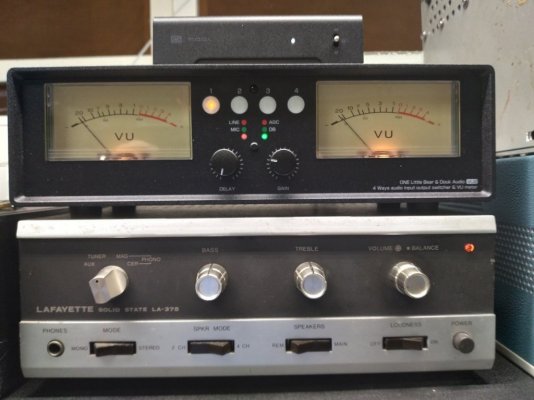Tried the Schiit at work today.
At first it sounded like I had turned the treble control down, but then I realized I had been used to the FiiO with its slightly boosted upper treble.
As the day went on the Schiit sounded better and better.
Here's the setup.

Maybe three weeks ago I took and found a source of switched 9 volts in the VU meter then added a 5 volt relay in parallel with the power switch in the amp. I did it that way so I could turn the amp on with its power switch if so desired. Because I do not use the record out jacks, I repurposed one of those for the 5 volt input to the relay coil.
I added an RCA jack to the VU meter which has the 9 volts going to it through a resistor to drop it to 5 volts when the relay coil is connected. I put the resistor there so that if for some reason there is a short I'm not shorting out a 9 volt supply, but am only causing 9 volts to be put across a resistor.
I have the power supply for the VU meter plugged into the unswitched outlet on the amp and the power supply for the DAC plugged into the switched outlet.
That way the whole thing turns on and off with the power button for the VU meter.
I also used a toslink cable to connect the DAC to the audio extractor. That way there's no electrical connection between the PC and stereo. I did not have a ground loop issue, but felt that would be better to keep them isolated from each other.
Plus that leaves the coax input for the idea I had with using an older CD ROM drive with a play pause button on it to serve as a CD player.
I could have used the DAC as a sound card, but IT would have to install the drivers and technically the work PCs aren't to be used for playing music anyways so they would have a big problem with that.
I was sort of expecting the Schiit to be larger than it is.
